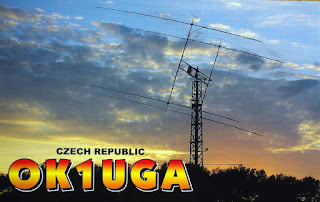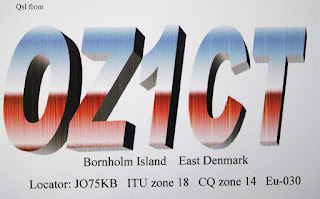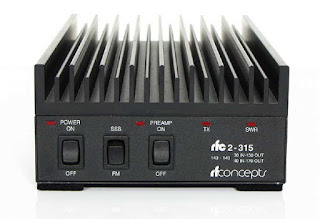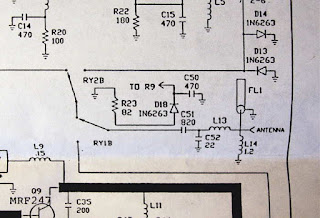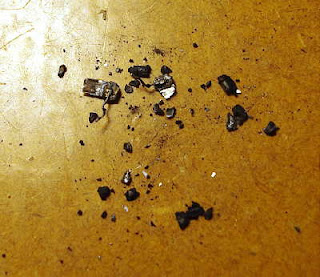Posts Tagged ‘2m’
 July’s EME Window
July’s EME Window
 With QSLs still arriving from previous 2m EME action, I was looking extra forward to late July's very short window.
With QSLs still arriving from previous 2m EME action, I was looking extra forward to late July's very short window.When last month's activity was interrupted by my 140W brick amplifier catching fire, I was anxious to see if my repairs and homebrew RFC would still allow me to play on the moon. With July's best-positioned moonrises being too close to the sun (which was also rising at the same time), I was only able to spend a short time over two days before the moon travelled too far to the south and into my neighbour's trees.
Luckily I was rewarded with what seemed like very good lunar conditions, enabling me to easily work six different stations ... three of them being all-time new ones and boosting my EME initials total to 112.
I2FAK Franco / 16x19 el array
RK3FG Anatoly / 4x15 el array
G4SWX John / 4x16 el array
F4DJK Paul / 4x11 el array / #110
F5AQX Andre / 4x11 el array / #111
DL9DBJ Hartmut / 4x10 el array / #112
In addition, DL1VPL told me that he was able to copy me with his single 12el Yagi during the QSO with I2FAK! Needless to say, a contact between two single Yagi stations would be truly remarkable. I've only been able to copy a single Yagi station once over the years.
| F4DJK's 4x11 el array |
 | |||||
| F5AQX's 4x11 el array |
 |
| DJ9DBJ's 4x10 el array |
I was gratified to see that letting the smoke out of my little amplifier last month apparently caused no permanent damage and the repair seems to be holding up ... but I'll leave the bottom off for now just in case it gets any more crazy ideas.
 July’s EME Window
July’s EME Window
 With QSLs still arriving from previous 2m EME action, I was looking extra forward to late July's very short window.
With QSLs still arriving from previous 2m EME action, I was looking extra forward to late July's very short window.When last month's activity was interrupted by my 140W brick amplifier catching fire, I was anxious to see if my repairs and homebrew RFC would still allow me to play on the moon. With July's best-positioned moonrises being too close to the sun (which was also rising at the same time), I was only able to spend a short time over two days before the moon travelled too far to the south and into my neighbour's trees.
Luckily I was rewarded with what seemed like very good lunar conditions, enabling me to easily work six different stations ... three of them being all-time new ones and boosting my EME initials total to 112.
I2FAK Franco / 16x19 el array
RK3FG Anatoly / 4x15 el array
G4SWX John / 4x16 el array
F4DJK Paul / 4x11 el array / #110
F5AQX Andre / 4x11 el array / #111
DL9DBJ Hartmut / 4x10 el array / #112
In addition, DL1VPL told me that he was able to copy me with his single 12el Yagi during the QSO with I2FAK! Needless to say, a contact between two single Yagi stations would be truly remarkable. I've only been able to copy a single Yagi station once over the years.
| F4DJK's 4x11 el array |
 | |||||
| F5AQX's 4x11 el array |
 |
| DJ9DBJ's 4x10 el array |
I was gratified to see that letting the smoke out of my little amplifier last month apparently caused no permanent damage and the repair seems to be holding up ... but I'll leave the bottom off for now just in case it gets any more crazy ideas.
 June Moonbounce Heats Up
June Moonbounce Heats Up
Last week's favorable northern declination of the Moon allowed me two days of activity, once my moonrises had lagged far enough behind the early sunrises.
With fixed elevation and not having the ability to track the moon as it rises, I can only operate for about two hours before the moon gets too high. The highest elevation that I am able to work seems to stop near 20 degrees.
With QSLs from earlier sessions still arriving, I noted last week's activity was down somewhat from the previous month ... summertime activities usually take priority over EME for most moonbouncers.
During my two mornings of moon time I worked five stations which included two new DXCC countries, bringing my 2m DXCC total to 30. Stations worked at the end of June were:
ON4AOI #106 (new country)
OH3AWW #107 (new country)
I2RV second QSO
DK9WI #108
IK6CAK #109
Interestingly, all of the stations answered one of my CQs, with one CQ having three different callers at one time ... pretty exciting and something that I don't think has occurred here before! But that wasn't the only excitement of the week.
In the middle of a CQ following my QSO with IK6CAK, I heard a faint 'crack' sound from my amplifier, an aging RF Concepts 2-135, followed by the unmistakable whiff of a 'too hot' electronic component ... every ham is familiar with this always unwelcome odor and it usually spells trouble.
During the next CQ, I saw a trace of smoke coming out of the amp's back corner vent holes, at which point I reluctantly shut things down in the middle of some superb EME conditions.
After tearing into the amplifier, the only thing that looked stressed was a small inductor (L14 below), part of the output filtering / impedance matching circuitry.
It looked a little darker and somewhat stressed and as I gave it a poke with a screwdriver blade, it immediately disintegrated into what you see below.
It was a small (1.2uH) encapsulated RFC which appeared to be wire-wound on a core material that I did not recognize and likely suitable for VHF. I surmised that after several years of 100% duty-cycle JT65 operation, the inductor had been over-stressed to the point of failure ... helping to filter all of those nasty high frequency harmonics can't be an easy job!
After a search of my RFC collection (see below), salvaged mostly from junked TVs, monitors, VCRs and other electronic cast-offs temporarily 'borrowed' for stripping from our local recycle center here on Mayne Island, I settled on a 1.2uH choke that I hoped would be a suitable replacement. It had just a few turns so I assumed it was wound on some sort of powdered iron or ferrite form. Whether or not it would behave at 144MHz was another question.
After reassembling the amplifier the following morning, I keyed up at full power during the EME window but halfway through my initial CQ I saw smoke and then flames coming from the inside of the case ... yikes! Shutting down immediately killed the fire and after tearing into the amp yet again, I saw that this time, the output coupling capacitor (C51) had completely destroyed itself.
The new inductor (L14) appeared a little heated, but I assumed it was only smoke-damaged from the nearby flameout of the capacitor. I replaced C51, an 820pF silver mica, with a higher rated one of the same value and, once again, gave it the smoke test ... literally.
After a few seconds, a whiff of smoke appeared from the back of the amp, followed by the SWR trip-out kicking in and shutting the amp down.
This time it appeared that the inductor was definitely complicit in the destruction of the capacitor as it was charred and black. I surmised that whatever core material the little inductor was wound upon, definitely was not suitable at 144MHz and had caused the little inductor to either change value or to saturate ... whatever it was doing had created a highly reactive condition in the output circuit, changing the output load impedance and sending the SWR sky-high.
This time I replaced the inductor with a homebrew one, wound on a plain phenolic former, hoping to avoid any ferro-magnetic / frequency compatibility issues. After reassembling the amplifier, it seemed to be happy once again and ran nicely for several 60 second JT65B sequences at full power with no smoke or component heating!
By this time I had run out of favorable EME windows as my moonrises were now too far to the south to keep me away from the neighbour's trees ... I'll just have to be patient and wait until the end of the month for the next definitive test. Let's hope there's no more smoke.
With fixed elevation and not having the ability to track the moon as it rises, I can only operate for about two hours before the moon gets too high. The highest elevation that I am able to work seems to stop near 20 degrees.
With QSLs from earlier sessions still arriving, I noted last week's activity was down somewhat from the previous month ... summertime activities usually take priority over EME for most moonbouncers.
During my two mornings of moon time I worked five stations which included two new DXCC countries, bringing my 2m DXCC total to 30. Stations worked at the end of June were:
ON4AOI #106 (new country)
OH3AWW #107 (new country)
I2RV second QSO
DK9WI #108
IK6CAK #109
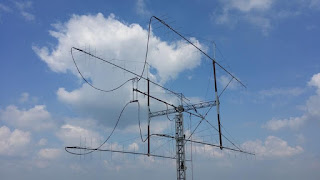 |
| ON4AOI - 4 X 14V / 14H array |
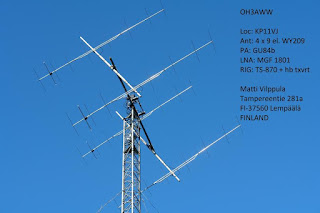 |
| OH3AWW - 4 X 9el array |
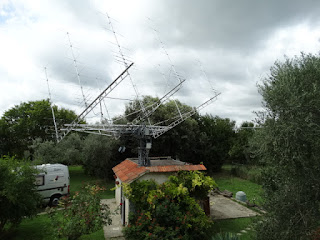 |
| IK6CAK - 9H / 6V 8el LFA array more |
In the middle of a CQ following my QSO with IK6CAK, I heard a faint 'crack' sound from my amplifier, an aging RF Concepts 2-135, followed by the unmistakable whiff of a 'too hot' electronic component ... every ham is familiar with this always unwelcome odor and it usually spells trouble.
During the next CQ, I saw a trace of smoke coming out of the amp's back corner vent holes, at which point I reluctantly shut things down in the middle of some superb EME conditions.
After tearing into the amplifier, the only thing that looked stressed was a small inductor (L14 below), part of the output filtering / impedance matching circuitry.
It looked a little darker and somewhat stressed and as I gave it a poke with a screwdriver blade, it immediately disintegrated into what you see below.
It was a small (1.2uH) encapsulated RFC which appeared to be wire-wound on a core material that I did not recognize and likely suitable for VHF. I surmised that after several years of 100% duty-cycle JT65 operation, the inductor had been over-stressed to the point of failure ... helping to filter all of those nasty high frequency harmonics can't be an easy job!
After a search of my RFC collection (see below), salvaged mostly from junked TVs, monitors, VCRs and other electronic cast-offs temporarily 'borrowed' for stripping from our local recycle center here on Mayne Island, I settled on a 1.2uH choke that I hoped would be a suitable replacement. It had just a few turns so I assumed it was wound on some sort of powdered iron or ferrite form. Whether or not it would behave at 144MHz was another question.
After reassembling the amplifier the following morning, I keyed up at full power during the EME window but halfway through my initial CQ I saw smoke and then flames coming from the inside of the case ... yikes! Shutting down immediately killed the fire and after tearing into the amp yet again, I saw that this time, the output coupling capacitor (C51) had completely destroyed itself.
The new inductor (L14) appeared a little heated, but I assumed it was only smoke-damaged from the nearby flameout of the capacitor. I replaced C51, an 820pF silver mica, with a higher rated one of the same value and, once again, gave it the smoke test ... literally.
After a few seconds, a whiff of smoke appeared from the back of the amp, followed by the SWR trip-out kicking in and shutting the amp down.
This time it appeared that the inductor was definitely complicit in the destruction of the capacitor as it was charred and black. I surmised that whatever core material the little inductor was wound upon, definitely was not suitable at 144MHz and had caused the little inductor to either change value or to saturate ... whatever it was doing had created a highly reactive condition in the output circuit, changing the output load impedance and sending the SWR sky-high.
This time I replaced the inductor with a homebrew one, wound on a plain phenolic former, hoping to avoid any ferro-magnetic / frequency compatibility issues. After reassembling the amplifier, it seemed to be happy once again and ran nicely for several 60 second JT65B sequences at full power with no smoke or component heating!
By this time I had run out of favorable EME windows as my moonrises were now too far to the south to keep me away from the neighbour's trees ... I'll just have to be patient and wait until the end of the month for the next definitive test. Let's hope there's no more smoke.
 June Moonbounce Heats Up
June Moonbounce Heats Up
Last week's favorable northern declination of the Moon allowed me two days of activity, once my moonrises had lagged far enough behind the early sunrises.
With fixed elevation and not having the ability to track the moon as it rises, I can only operate for about two hours before the moon gets too high. The highest elevation that I am able to work seems to stop near 20 degrees.
With QSLs from earlier sessions still arriving, I noted last week's activity was down somewhat from the previous month ... summertime activities usually take priority over EME for most moonbouncers.
During my two mornings of moon time I worked five stations which included two new DXCC countries, bringing my 2m DXCC total to 30. Stations worked at the end of June were:
ON4AOI #106 (new country)
OH3AWW #107 (new country)
I2RV second QSO
DK9WI #108
IK6CAK #109
Interestingly, all of the stations answered one of my CQs, with one CQ having three different callers at one time ... pretty exciting and something that I don't think has occurred here before! But that wasn't the only excitement of the week.
In the middle of a CQ following my QSO with IK6CAK, I heard a faint 'crack' sound from my amplifier, an aging RF Concepts 2-135, followed by the unmistakable whiff of a 'too hot' electronic component ... every ham is familiar with this always unwelcome odor and it usually spells trouble.
During the next CQ, I saw a trace of smoke coming out of the amp's back corner vent holes, at which point I reluctantly shut things down in the middle of some superb EME conditions.
After tearing into the amplifier, the only thing that looked stressed was a small inductor (L14 below), part of the output filtering / impedance matching circuitry.
It looked a little darker and somewhat stressed and as I gave it a poke with a screwdriver blade, it immediately disintegrated into what you see below.
It was a small (1.2uH) encapsulated RFC which appeared to be wire-wound on a core material that I did not recognize and likely suitable for VHF. I surmised that after several years of 100% duty-cycle JT65 operation, the inductor had been over-stressed to the point of failure ... helping to filter all of those nasty high frequency harmonics can't be an easy job!
After a search of my RFC collection (see below), salvaged mostly from junked TVs, monitors, VCRs and other electronic cast-offs temporarily 'borrowed' for stripping from our local recycle center here on Mayne Island, I settled on a 1.2uH choke that I hoped would be a suitable replacement. It had just a few turns so I assumed it was wound on some sort of powdered iron or ferrite form. Whether or not it would behave at 144MHz was another question.
After reassembling the amplifier the following morning, I keyed up at full power during the EME window but halfway through my initial CQ I saw smoke and then flames coming from the inside of the case ... yikes! Shutting down immediately killed the fire and after tearing into the amp yet again, I saw that this time, the output coupling capacitor (C51) had completely destroyed itself.
The new inductor (L14) appeared a little heated, but I assumed it was only smoke-damaged from the nearby flameout of the capacitor. I replaced C51, an 820pF silver mica, with a higher rated one of the same value and, once again, gave it the smoke test ... literally.
After a few seconds, a whiff of smoke appeared from the back of the amp, followed by the SWR trip-out kicking in and shutting the amp down.
This time it appeared that the inductor was definitely complicit in the destruction of the capacitor as it was charred and black. I surmised that whatever core material the little inductor was wound upon, definitely was not suitable at 144MHz and had caused the little inductor to either change value or to saturate ... whatever it was doing had created a highly reactive condition in the output circuit, changing the output load impedance and sending the SWR sky-high.
This time I replaced the inductor with a homebrew one, wound on a plain phenolic former, hoping to avoid any ferro-magnetic / frequency compatibility issues. After reassembling the amplifier, it seemed to be happy once again and ran nicely for several 60 second JT65B sequences at full power with no smoke or component heating!
By this time I had run out of favorable EME windows as my moonrises were now too far to the south to keep me away from the neighbour's trees ... I'll just have to be patient and wait until the end of the month for the next definitive test. Let's hope there's no more smoke.
With fixed elevation and not having the ability to track the moon as it rises, I can only operate for about two hours before the moon gets too high. The highest elevation that I am able to work seems to stop near 20 degrees.
With QSLs from earlier sessions still arriving, I noted last week's activity was down somewhat from the previous month ... summertime activities usually take priority over EME for most moonbouncers.
During my two mornings of moon time I worked five stations which included two new DXCC countries, bringing my 2m DXCC total to 30. Stations worked at the end of June were:
ON4AOI #106 (new country)
OH3AWW #107 (new country)
I2RV second QSO
DK9WI #108
IK6CAK #109
 |
| ON4AOI - 4 X 14V / 14H array |
 |
| OH3AWW - 4 X 9el array |
 |
| IK6CAK - 9H / 6V 8el LFA array more |
In the middle of a CQ following my QSO with IK6CAK, I heard a faint 'crack' sound from my amplifier, an aging RF Concepts 2-135, followed by the unmistakable whiff of a 'too hot' electronic component ... every ham is familiar with this always unwelcome odor and it usually spells trouble.
During the next CQ, I saw a trace of smoke coming out of the amp's back corner vent holes, at which point I reluctantly shut things down in the middle of some superb EME conditions.
After tearing into the amplifier, the only thing that looked stressed was a small inductor (L14 below), part of the output filtering / impedance matching circuitry.
It looked a little darker and somewhat stressed and as I gave it a poke with a screwdriver blade, it immediately disintegrated into what you see below.
It was a small (1.2uH) encapsulated RFC which appeared to be wire-wound on a core material that I did not recognize and likely suitable for VHF. I surmised that after several years of 100% duty-cycle JT65 operation, the inductor had been over-stressed to the point of failure ... helping to filter all of those nasty high frequency harmonics can't be an easy job!
After a search of my RFC collection (see below), salvaged mostly from junked TVs, monitors, VCRs and other electronic cast-offs temporarily 'borrowed' for stripping from our local recycle center here on Mayne Island, I settled on a 1.2uH choke that I hoped would be a suitable replacement. It had just a few turns so I assumed it was wound on some sort of powdered iron or ferrite form. Whether or not it would behave at 144MHz was another question.
After reassembling the amplifier the following morning, I keyed up at full power during the EME window but halfway through my initial CQ I saw smoke and then flames coming from the inside of the case ... yikes! Shutting down immediately killed the fire and after tearing into the amp yet again, I saw that this time, the output coupling capacitor (C51) had completely destroyed itself.
The new inductor (L14) appeared a little heated, but I assumed it was only smoke-damaged from the nearby flameout of the capacitor. I replaced C51, an 820pF silver mica, with a higher rated one of the same value and, once again, gave it the smoke test ... literally.
After a few seconds, a whiff of smoke appeared from the back of the amp, followed by the SWR trip-out kicking in and shutting the amp down.
This time it appeared that the inductor was definitely complicit in the destruction of the capacitor as it was charred and black. I surmised that whatever core material the little inductor was wound upon, definitely was not suitable at 144MHz and had caused the little inductor to either change value or to saturate ... whatever it was doing had created a highly reactive condition in the output circuit, changing the output load impedance and sending the SWR sky-high.
This time I replaced the inductor with a homebrew one, wound on a plain phenolic former, hoping to avoid any ferro-magnetic / frequency compatibility issues. After reassembling the amplifier, it seemed to be happy once again and ran nicely for several 60 second JT65B sequences at full power with no smoke or component heating!
By this time I had run out of favorable EME windows as my moonrises were now too far to the south to keep me away from the neighbour's trees ... I'll just have to be patient and wait until the end of the month for the next definitive test. Let's hope there's no more smoke.
 April Moonbounce
April Moonbounce
 |
| My Moonrise |
This week I had several days of unobstructed ocean moonrises as the Moon peaked on its monthly northern declination track. Thanks to the recent topping of my next door neighbour's large Douglas Fir, and removal of low-hanging branches, I am now able to track moonrises a little further to the south than before and can add two more EME days that were previously blocked by the large tree. All operations are on 2m JT65B mode, using a 9el Yagi and 140W output.
When I started (April 1) conditions looked as if they should be good, with lunar perigee (Moon's closest approach), degradation (background skynoise) and declination all looking favorable, but I was in for a surprise.
The rising yellow plot indicates the Earth-Moon distance growing further apart (increasing path losses) while the red plot indicates fluctuation in daily skynoise (temperature) near the moon. The blue plot indicates declination track from north to south ... for me, the higher the better.
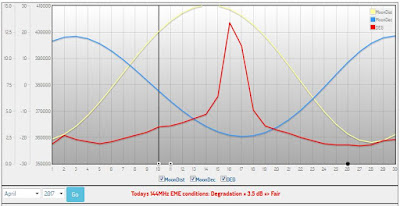 |
| courtesy: http://www.mmmonvhf.de/eme.php |
On day three, five new 'initials' were worked including one new state (New York) and two new DXCC countries! Truly surprising was that two of the stations worked were using just two Yagis, with both stations answering one of my 'CQ's.
Good conditions continued for the next few days, bringing my initials count from #87 to # 95, with the following stations all going into the log, turning a disappointing start into one of the best lunar sessions I have encountered:
HA6NQ, LZ2FO (two 13 el Yagis), EB5EEO, K2ZJ (two 14 el Yagis), DK5YA, S52LM, F8DO, PA5Y, SV6KRW, UA3PTW, OK1UGA.
April's operation brought my 2m DXCC count to 29 and states worked total to 27.
| SV6KRW's 4 x 8el Array |
| EB5EEO's 4 x 32el Cross-polarized Array (16V / 16H) |
 |
| DK5YA's 4 x 22 Cross-polarized Array (11V / 11H) |
 April Moonbounce
April Moonbounce
 |
| My Moonrise |
This week I had several days of unobstructed ocean moonrises as the Moon peaked on its monthly northern declination track. Thanks to the recent topping of my next door neighbour's large Douglas Fir, and removal of low-hanging branches, I am now able to track moonrises a little further to the south than before and can add two more EME days that were previously blocked by the large tree. All operations are on 2m JT65B mode, using a 9el Yagi and 140W output.
When I started (April 1) conditions looked as if they should be good, with lunar perigee (Moon's closest approach), degradation (background skynoise) and declination all looking favorable, but I was in for a surprise.
The rising yellow plot indicates the Earth-Moon distance growing further apart (increasing path losses) while the red plot indicates fluctuation in daily skynoise (temperature) near the moon. The blue plot indicates declination track from north to south ... for me, the higher the better.
 |
| courtesy: http://www.mmmonvhf.de/eme.php |
On day three, five new 'initials' were worked including one new state (New York) and two new DXCC countries! Truly surprising was that two of the stations worked were using just two Yagis, with both stations answering one of my 'CQ's.
Good conditions continued for the next few days, bringing my initials count from #87 to # 95, with the following stations all going into the log, turning a disappointing start into one of the best lunar sessions I have encountered:
HA6NQ, LZ2FO (two 13 el Yagis), EB5EEO, K2ZJ (two 14 el Yagis), DK5YA, S52LM, F8DO, PA5Y, SV6KRW, UA3PTW, OK1UGA.
April's operation brought my 2m DXCC count to 29 and states worked total to 27.
| SV6KRW's 4 x 8el Array |
| EB5EEO's 4 x 32el Cross-polarized Array (16V / 16H) |
 |
| DK5YA's 4 x 22 Cross-polarized Array (11V / 11H) |
 March Moonbounce
March Moonbounce
Tied up with other radio happenings, I missed getting on EME during the moon's last two orbits of the planet. I was able to get back at it last week, with three days of unobstructed ocean moonrises as the moon travelled through its northern declination peak.
Conditions seemed unusually good and I was able to complete several contacts with my small station ... a single 9el m2 Yagi and an older 2m 140W brick amplifier. The Yagi is nestled atop my 50' tower's mast, between my triband Yagi, and Yagis for 6m and 70cm. The tower is located about 100' from the ocean and on these favorable moonrises, looks towards the moon directly over saltwater. The antenna appears to develop the full 'theoretical' 6db of seagain and performance seems fairly similar to what I would expect from a box of four similar Yagis.
Stations worked last week (all on JT65B) where: I3MEK, WA3QPX, G4DML, EA5SR, SP8NR, PA0JMV and K9MRI. The first three stations had been previously worked but answered my CQ while the remainder where all new, representing 'initials' #84 - #87 using this simple system.
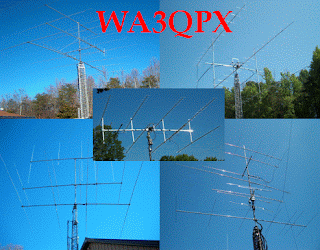 | |
| WA3QPX 4 X 28 el Yagi array |
 |
| EA8SR's 4 X 9el Yagi array |
| G4DML's 4 X 8el Yagi array |
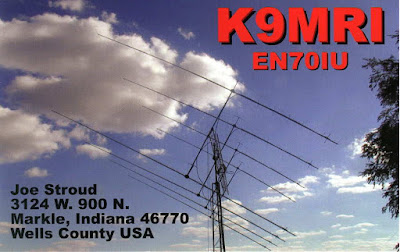 |
| K9MRI's monster array - 8 x 28el Yagis |
K9MRI provided the best signal report I had ever received on moonbounce, a -15db and indicated that my signal was audible during our QSO!
WA3QPX represented a new 2m state, which made me wonder what my confirmed state totals had reached ... 26 now, including EME and terrestrial contacts. Interestingly, my 2m DXCC total also stands at this same number ... 26 confirmed.
With such a low ERP, I often think that I will eventually run out of stations that I can work on EME, yet I continue to see many new stations every time I get on the air ... likely enough to keep me challenged for some time yet.
I often hear stations better than they are hearing me so if I do run out of stations, the next logical step would be a modest 3db increase in my power by building a simple 300W amplifier. An extra 3db would probably open up a large number of new challenging target stations to work with.
I have a box of NIB 4CX250Bs and sockets that have been looking at me longingly for some time!





